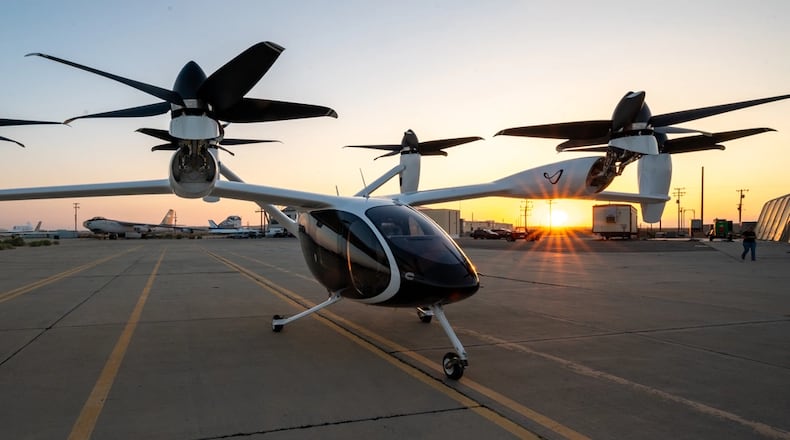“On-base operations with Joby aircraft will be used to demonstrate a range of logistics missions, including cargo and passenger transportation, and will be operated by both Joby and U.S. Air Force personnel,” Joby said in its release. “In partnership with the U.S. Air Force, NASA will also use the aircraft for research focused on how these aircraft could fit into the national airspace, benefiting the entire air taxi industry.”
Joby’s aircraft, which is already flying at Edwards, is the first electric air taxi to be stationed on a U.S. military base and is believed to be the first delivery of an electric air taxi in the U.S., as part of Joby’s $131 million AFWERX Agility Prime contract with the U.S. Air Force.
The Air Force Research Laboratory, or AFRL, which oversees the Agility Prime effort, is based at Wright-Patterson Air Force Base.
Joby, a much-watched player in the emerging field of electric vertical takeoff and landing aircraft — often called “flying cars” — will build an aircraft production operation near Dayton International Airport, valued at up to $500 million, supported by as much as $325 million in state and local incentives, the company and the state of Ohio said last week.
Joby’s current and previous work with the Department of Defense represents a total potential contract value of $163 million, the largest in the industry, the company said Monday.
The Agility Prime contract provides for up to nine aircraft to the Air Force and other federal agencies. A second aircraft for Edwards is planned for early 2024.
The aircraft, which was the first built on Joby’s pilot production line in Marina, Calif., will be stationed at Edwards for at least the next year, with charging and ground support equipment provided on-base by Joby in a facility purpose-built by the Air Force for joint flight test operations.
The service and Joby will conduct joint flight testing and operations to demonstrate the aircraft’s capabilities in realistic mission settings, Joby said.
On-base operations will also include the training of Air Force pilots and aircraft maintenance crews.
Joby has said it is preparing the launch of commercial passenger service in 2025.
“We’re proud to join the ranks of revolutionary aircraft that first demonstrated their capabilities at Edwards Air Force Base, including the first American jet fighter, the first supersonic aircraft, and many others that have pushed the boundaries of aviation technology,” JoeBen Bevirt, Joby founder and chief executive, said in the company’s statement Monday.
“Agility Prime’s stated objective in 2020 was to work towards an operational capability for transformative vertical lift in the DOD by 2023,” said Col Elliott Leigh, AFWERX director and chief commercialization officer for the Air Force. “The arrival of Joby’s aircraft at Edwards ... is an important step towards achieving this objective.”
“NASA’s participation in the Joby and AFWERX project will provide our researchers with hands-on experience with a representative eVTOL (electric vertical takeoff and landing) vehicle, concentrated on how these types of aircraft could fit into the national airspace for everyday use, that will inform NASA’s effort in supporting the entire eVTOL industry,” said NASA research pilot Wayne Ringelberg.
Joby’s Dayton-area facility will be capable of delivering up to 500 aircraft per year near Dayton International Airport, supporting up to 2,000 jobs, the company said.
The 140-acre site was picked because it has the potential to support growth over time, providing enough land to build up to two million square feet of manufacturing space.
Construction of the plant is expected to start in 2024 and it is expected to come online in 2025, with existing nearby buildings to be part of the operation.
About the Author


